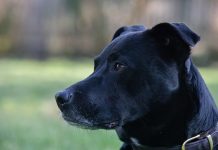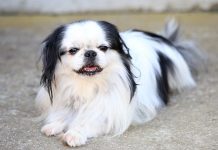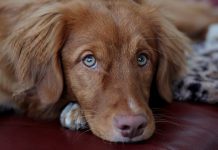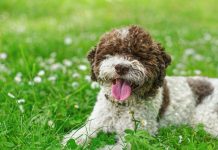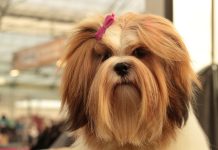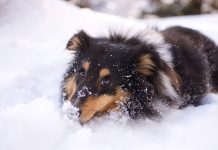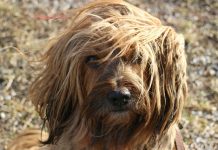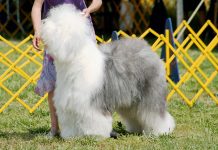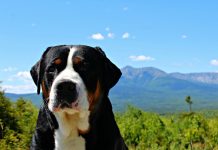History and Origins of the English Mastiff Breed

The English Mastiff, also known simply as the Mastiff, is a breed with a long and storied history. Here’s an overview of its origins:
- Ancient Roots: The Mastiff is one of the oldest breeds, with roots dating back to ancient civilizations such as the Babylonians, Assyrians, and Phoenicians. They were prized as war dogs, guard dogs, and hunting companions.
- Roman Times: Mastiffs were brought to Britain by the Romans around 55 BC and were used in the arenas for blood sports and as guard dogs. They were known for their size, strength, and imposing presence.
- Guardians and Protectors: Throughout history, Mastiffs were valued as guardians of castles, estates, and livestock. Their intimidating size and protective nature made them effective deterrents against intruders and predators.
- Noble Companions: Mastiffs were favored by nobility and royalty in Europe, including King Henry VIII of England and Queen Elizabeth I. They were cherished for their loyalty and gentle temperament within the home.
- Decline and Revival: By the mid-19th century, the Mastiff breed had declined in numbers in Britain. However, efforts to revive the breed were successful, leading to the establishment of the modern English Mastiff breed standard.
- Breed Development: The modern English Mastiff was developed with a focus on preserving the breed’s noble appearance, gentle temperament, and imposing stature. Today, Mastiffs are beloved companions and show dogs worldwide.
Physical Characteristics and Appearance of English Mastiffs
The English Mastiff is a massive and powerful breed with distinct physical characteristics. Here are the key features of the breed’s appearance:
- Size: English Mastiffs are one of the largest dog breeds, with males typically standing 30 inches (76 cm) or more at the shoulder and weighing between 160 to 230 pounds (73 to 104 kg). Females are slightly smaller but still substantial in size.
- Build: Mastiffs have a strong and muscular build, with a deep chest, broad shoulders, and sturdy limbs. Despite their size, they should appear balanced and well-proportioned.
- Head: The breed’s head is massive and square-shaped, with a broad skull and pronounced muzzle. The forehead is wrinkled when alert, adding to the breed’s imposing appearance.
- Ears: English Mastiffs have medium-sized ears that are set high on the head and hang close to the cheeks. The ears are v-shaped and slightly rounded at the tips.
- Eyes: Mastiffs have dark-colored, medium-sized eyes that convey a gentle and alert expression. The eyes are set wide apart on the face.
- Coat: The Mastiff’s coat is short, straight, and dense, providing good weather resistance. The coat comes in various colors, including fawn, apricot, and brindle, with a dark mask on the face.
- Tail: The tail of a Mastiff is set high and reaches to the hocks. It is carried low and may have a slight curve, but it should not curl over the back.
- Gait: Despite their massive size, English Mastiffs move with a powerful and effortless gait. Their movement should be smooth and balanced, reflecting their strength and agility.
- Expression: Mastiffs have a dignified and noble expression that reflects their calm and confident temperament. Their demeanor is typically gentle and affectionate, especially with their family members.
- Overall Impression: The overall impression of an English Mastiff should be that of a majestic and imposing yet gentle and noble companion. Their size and stature command respect, but their temperament is calm, steady, and devoted.
English Mastiffs are known for their loyalty, gentleness, and protective nature. They make excellent family companions and are particularly good with children due to their patient and tolerant demeanor. However, due to their size, they require proper training, socialization, and regular exercise to thrive as well-rounded pets.
English Mastiff Temperament and Personality Traits
The English Mastiff is a gentle giant known for its calm and affectionate nature. Here are the key temperament and personality traits of this majestic breed:
- Gentle and Affectionate: English Mastiffs are famously gentle and affectionate companions. They form strong bonds with their families and are particularly devoted to children.
- Loyal and Protective: Mastiffs are fiercely loyal to their families and are natural protectors. They have a strong sense of loyalty and will instinctively protect their loved ones if they sense danger.
- Courageous and Dignified: Mastiffs have a courageous demeanor combined with a dignified presence. They exude confidence and are not easily intimidated.
- Good-Natured and Calm: Despite their imposing size, Mastiffs have a calm and easygoing temperament. They are typically laid-back and enjoy lounging with their family members.
- Patient and Tolerant: English Mastiffs are known for their patience, especially with children. They can tolerate rough play and enjoy being part of family activities.
- Watchful and Alert: Mastiffs make excellent watchdogs due to their keen sense of awareness. They are alert to their surroundings and will bark to alert their owners of any perceived threats.
- Mellow Demeanor: Mastiffs have a mellow demeanor and are not overly active or hyperactive. They are content to relax indoors with their family but still require daily exercise.
- Sociable with Proper Training: Mastiffs are generally friendly towards strangers when properly socialized from a young age. Early socialization helps them become well-adjusted adults.
- Moderate Energy Level: Mastiffs have a moderate energy level and enjoy daily walks and play sessions. However, they are not high-energy dogs and are content with moderate exercise.
- Reserved Towards Strangers: While Mastiffs are friendly, they can be reserved or aloof towards strangers. Early socialization is essential to ensure they are well-mannered and confident in various situations.
Training and Socialization Needs for English Mastiffs
English Mastiffs are intelligent dogs but can be independent thinkers. Proper training and socialization are essential to help them become well-mannered and well-adjusted family members. Here are tips for training and socializing your Mastiff:
- Start Early: Begin training and socialization as soon as you bring your Mastiff puppy home. Early exposure to various people, places, and situations will help them develop into confident adults.
- Positive Reinforcement: Use positive reinforcement techniques such as treats, praise, and play to motivate and reward your Mastiff during training sessions. Avoid harsh methods or punishment.
- Basic Obedience Training: Teach your Mastiff basic obedience commands such as sit, stay, come, and heel. Be patient and consistent with training, as Mastiffs can be stubborn at times.
- Socialization with People: Introduce your Mastiff to different people of all ages, including children, adults, and strangers. Supervise interactions to ensure positive experiences.
- Socialization with Other Animals: Expose your Mastiff to other dogs and animals in controlled settings. Early socialization helps prevent aggression and ensures good behavior around other pets.
- Leash Training: Mastiffs are strong dogs, so leash training is essential to prevent pulling and ensure good manners on walks. Use a sturdy leash and harness for control.
- Consistent Rules and Boundaries: Establish consistent rules and boundaries for your Mastiff and enforce them with kindness and patience. Mastiffs respond well to a calm and assertive leader.
- Patience and Consistency: Training a Mastiff requires patience and consistency. Keep training sessions short and enjoyable to maintain your dog’s interest and focus.
- Exercise Needs: Provide regular exercise to keep your Mastiff physically and mentally stimulated. Daily walks, playtime, and interactive games are beneficial for their well-being.
- Positive Experiences: Create positive experiences for your Mastiff during training and socialization. Make learning fun and rewarding to strengthen the bond between you and your dog.
By investing time and effort into training and socialization, you can help your English Mastiff develop into a well-behaved, confident, and loving companion. Mastiffs thrive on companionship and positive interactions with their family members, making them cherished members of the household.
Health Considerations and Common Issues in English Mastiffs
English Mastiffs are generally healthy dogs, but like all breeds, they can be prone to certain health issues. Responsible breeding practices and proactive veterinary care are essential for maintaining the health and well-being of English Mastiffs. Here are common health considerations and issues to be aware of:
- Gastric Dilatation-Volvulus (GDV): Also known as bloat, GDV is a life-threatening condition where the stomach fills with gas and twists. This can occur suddenly and requires immediate veterinary intervention. Symptoms include restlessness, bloating of the abdomen, unproductive vomiting, and weakness.
- Hip Dysplasia: A common orthopedic condition in large breeds, hip dysplasia occurs when the hip joint doesn’t develop properly, leading to arthritis and mobility issues. Regular screening and X-rays are important for early detection.
- Elbow Dysplasia: Similar to hip dysplasia, elbow dysplasia affects the elbow joint and can cause lameness, pain, and arthritis. Elbow evaluations are recommended, especially for breeding dogs.
- Cardiac Issues: English Mastiffs may be prone to cardiac conditions such as dilated cardiomyopathy (enlarged heart) and subaortic stenosis (narrowing of the heart’s outflow tract). Regular cardiac evaluations are important for early detection and management.
- Orthopedic Conditions: In addition to hip and elbow dysplasia, English Mastiffs can be susceptible to other orthopedic issues such as osteoarthritis, cruciate ligament injuries, and osteochondritis dissecans (OCD).
- Entropion and Ectropion: Mastiffs may be prone to eyelid abnormalities such as entropion (inward rolling of the eyelid) and ectropion (outward rolling of the eyelid), which can cause irritation and require corrective surgery.
- Cancer: Mastiffs have a higher risk of developing certain types of cancer, including osteosarcoma (bone cancer), lymphoma, and mast cell tumors. Early detection and treatment are crucial for managing these conditions.
- Obesity: Due to their large size and tendency to be less active, English Mastiffs are prone to obesity. Maintaining a healthy diet and providing regular exercise are important for weight management.
- Skin Issues: Mastiffs may experience skin problems such as allergies, hot spots, and infections. Regular grooming, proper nutrition, and veterinary care can help prevent and manage skin issues.
- Heat Sensitivity: Mastiffs are sensitive to heat due to their brachycephalic (short-nosed) facial structure. They should be kept cool and hydrated in hot weather to prevent heatstroke.
Living with an English Mastiff: Suitable Environments and Lifestyle Considerations

English Mastiffs are well-suited to certain environments and lifestyles due to their size and temperament. Here are considerations for living with an English Mastiff:
- Space: English Mastiffs require ample indoor space due to their large size. They are best suited to homes with a fenced yard where they can move around comfortably. Indoor living spaces should be spacious and accommodating.
- Climate: Mastiffs are sensitive to extreme temperatures, especially heat. They should have access to shade, cool water, and air-conditioned environments during hot weather.
- Exercise Needs: While not overly active, English Mastiffs benefit from regular, moderate exercise to maintain muscle tone and prevent obesity. Daily walks and play sessions are recommended.
- Grooming: Mastiffs have short coats that are easy to maintain with regular brushing. They should be bathed as needed and their ears cleaned regularly to prevent infections.
- Training and Socialization: Early training and socialization are essential for English Mastiffs to develop good manners and confidence. They respond well to positive reinforcement techniques.
- Family Interaction: Mastiffs are affectionate and enjoy being part of the family. They are generally good with children but should be supervised due to their size.
- Safety Precautions: Due to their size and strength, Mastiffs should be taught proper leash manners and supervised around small children and other pets. Use a sturdy harness for walks.
- Nutrition: Feed your Mastiff a high-quality diet appropriate for their age, size, and activity level. Avoid overfeeding to prevent obesity and related health issues.
- Veterinary Care: Schedule regular veterinary check-ups, vaccinations, and preventive care to monitor your Mastiff’s health and address any potential issues early.
- Comfortable Living Environment: Provide a comfortable and climate-controlled living environment for your Mastiff, with access to soft bedding and indoor areas.
By understanding the health considerations and lifestyle needs of English Mastiffs, you can provide them with a safe, comfortable, and fulfilling life. Proper care, regular veterinary attention, and a loving environment will help ensure that your Mastiff remains happy and healthy for years to come.
English Mastiff Variations and Breeding Practices
The English Mastiff is a distinct breed with specific breed standards, but variations can still occur within the breed based on lineage, genetics, and breeding practices. Here’s an overview of English Mastiff variations and breeding practices:
Variations in English Mastiffs:
- Size: While English Mastiffs are generally large dogs, there can be variations in size within the breed. Some individuals may be slightly smaller or larger than the average standard. Breeders aim to maintain a consistent size range according to breed standards.
- Coat Color: English Mastiffs come in various coat colors, including fawn, apricot, brindle, and occasionally other shades. The color patterns and markings can vary slightly among individuals.
- Head and Body Structure: Breeders may selectively breed for certain head and body proportions, such as a broad skull, well-defined stop, and strong muzzle. These characteristics contribute to the breed’s distinctive appearance.
- Temperament and Behavior: While English Mastiffs generally exhibit similar temperament traits, there can be variations in individual personality traits. Some may be more laid-back and gentle, while others may be slightly more energetic or assertive.
Breeding Practices for English Mastiffs:
- Health Screening: Responsible breeders prioritize health screening for breeding dogs to minimize the risk of passing on genetic health issues. Common health screenings for English Mastiffs include hip and elbow evaluations, cardiac evaluations, and eye examinations.
- Breed Standard Adherence: Ethical breeders adhere to the breed standard set by kennel clubs such as the American Kennel Club (AKC) or the Kennel Club (UK). The breed standard outlines ideal characteristics, including appearance, temperament, and structure.
- Temperament Selection: Reputable breeders focus on breeding dogs with stable, gentle, and predictable temperaments. This helps ensure that puppies inherit desirable personality traits and are well-suited to family life.
- Genetic Diversity: Responsible breeders strive to maintain genetic diversity within the English Mastiff gene pool. This helps reduce the risk of inherited health conditions and promotes overall breed health.
- Pedigree Research: Ethical breeders maintain detailed pedigree records and lineage information for their breeding dogs. They track the ancestry and health history of each dog to make informed breeding decisions.
- Ethical Placement of Puppies: Responsible breeders prioritize the well-being of their puppies and ensure they are placed in suitable homes. They educate potential puppy owners about the breed’s needs and characteristics and provide ongoing support and guidance.
- Continued Education: Dedicated English Mastiff breeders are committed to ongoing education and improvement. They stay updated on the latest research, trends, and advancements in dog breeding to contribute positively to the breed’s future.
By supporting responsible breeding practices and working with reputable breeders, English Mastiff enthusiasts can help preserve the breed’s unique characteristics and ensure the health and well-being of future generations of English Mastiffs. Ethical breeding practices contribute to the longevity and sustainability of the breed while promoting responsible pet ownership.
50 Best Names with Meanings for English Mastiffs
Naming your English Mastiff can be a fun and meaningful process! Here are 50 best names with meanings that suit the majestic and noble nature of this impressive breed:
- Titan – Symbolizing strength and power
- Luna – Latin for moon, serene and beautiful
- Maximus – Greatest, reflecting their size
- Athena – Greek goddess of wisdom and courage
- Thor – Norse god of thunder, strong and mighty
- Duchess – Regal and elegant
- Zeus – King of the gods, representing authority
- Sable – Dark and dignified coat color
- Ragnar – Warrior, fitting for a strong dog
- Nova – New and brilliant
- Bane – Cause of distress or destruction, a strong name
- Fiona – Fair, reflecting beauty and grace
- Hercules – Heroic and powerful
- Goliath – Giant and imposing
- Stella – Star, shining and radiant
- Brutus – Strong and fierce
- Cleo – Glorious and regal
- Kai – Sea, symbolizing strength and depth
- Juno – Roman goddess of protection
- Harley – From the meadow of the hares, playful
- Rex – Latin for king, a fitting name for a majestic dog
- Sasha – Defender of mankind
- Gunner – Bold and fearless
- Aria – Melody or air, graceful and musical
- Moose – Large and imposing, like the animal
- Ivy – Symbol of strength and determination
- Bruno – Brown-haired, suitable for a Mastiff with brown markings
- Nova – New and brilliant
- Odin – Norse god of wisdom and war
- Xena – Warrior princess, strong and fearless
- Maverick – Independent and bold
- Cassius – Vain or empty, a strong name
- Zara – Princess, elegant and regal
- Bodhi – Enlightenment or awakening
- Magnus – Great and mighty
- Mila – Gracious and dear
- Hunter – One who hunts, strong and focused
- Pharaoh – King of ancient Egypt, majestic and commanding
- Zelda – Battle maiden, strong and fierce
- Jax – God has been gracious, a powerful name
- Lola – Strong woman, suitable for a female Mastiff
- Cyrus – Sun, representing warmth and strength
- Nyx – Greek goddess of the night, mysterious and powerful
- Loki – Norse trickster god, mischievous and clever
- Willow – Graceful and resilient
- Alistair – Defender of the people
- Valkyrie – Norse female warrior, strong and fearless
- Kona – Lady, suitable for a female Mastiff
- Ajax – Greek hero, known for his strength and courage
- Bella – Beautiful and beloved
Choose a name that resonates with your English Mastiff’s personality, appearance, and the qualities you admire. Whether you prefer a strong and powerful name or a more elegant and regal name, there’s a perfect fit waiting for your noble companion!

In conclusion, this comprehensive guide to English Mastiff dogs has provided a detailed exploration of this impressive and noble breed. Throughout our discussion, we’ve delved into the history, distinctive characteristics, and essential care considerations that define English Mastiffs. Known for their massive size, gentle temperament, and loyalty, English Mastiffs make exceptional companions for experienced dog owners and families seeking a devoted and protective pet. They require proper training and socialization to thrive as well-rounded pets. As you embark on your journey with an English Mastiff, may you appreciate their unique qualities and form a strong bond with this remarkable breed, creating lasting companionship and joy together.







